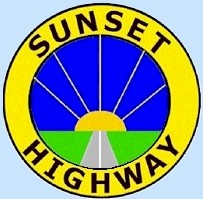
The Historic Sunset Highway
in Washington
Woodinville

The Historic Sunset Highway
in Washington
Woodinville
Woodinville
The first people of the area were a subgroup of the Duwamish called the "Willow People" They had a village at the mouth of Bear Creek. The first American settlers to make their homes in the aera was in the 1871 when Ira and Susan Woodin came and started a homestead on the east edge of the Sammamish Slough. There 160 acre farm was just north of today’s NE Woodinville Drive near its intersection with Juanita-Woodinville Way NE. More and more people began to move in and by 1886 Woodinville had a population of 60. The Woodin home soon became the center of the new community, serving as its first school from 1878 until 1883, its first church until 1880, and an informal doctor’s office. The first post office beginning in 1881 was run out of the Woodin's home.
There were no roads in the area in the beginning and the slough was used to travel between Seattle and Woodinville. Back then the slough was 30 miles long and twisted and wound it's way to Lake Washington. The slough frequently flooded the fertile valley and efforts to control the flooding began in the 1920's. In 1965, a large scale project was undertaken and the slough was straightened and the length of the slough was reduced by over 50% to 14 miles.
The first steamer the Mudhen, operated between Lake Sammamish and Lake Washington from 1876 to 1884 when it was replaced by the "Squak". In 1887 The Seattle Lakeshore & Eastern Railroad reached Woodinville, which made the steamer less important although it operated until 1916 when Lake Washington was lowered that made the slough too shallow for steamboat travel. In 1900, the Northern Pacific built it's Belt Line between Renton and Sumas and it crossed the Seattle Lakeshore & Eastern at Woodinville. Railroad tracks from Seattle, Sumas, Renton and North Bend and converged in Woodinville. I can remember that well into the 1970's when Woodinville was called "Hooterville", because of the many locomotive engines blowing their horns.
By 1909, Woodinville had 4 hotels, 2 sawmills, 2 shingle mills, a feed store, blacksmith shop, and several manufacturers. By 1929 the population was 780. When the Bothell Branch of the Sunset Highway was completed in 1926, Woodinville began to grow rapidly and became a large agricultural area supplying meat, dairy and vegetables to the citizens of the Puget Sound region.
In 1975, the Hollywood Farm was converted into the Chateau Ste. Michelle Winery. Today there are over 100 wineries and distilleries in the Woodinville Wine District that stretches from Hollywood to Woodinville and now has become a favorite tourist destination for wine aficionados.
Today Woodinville is part of the suburban eastside and the main business district has moved to the east, where there is plenty of shopping and places to eat. The old Bothell Branch between Woodinville to Bothell is no longer and main transportation route so the original town of Woodinville has not changed all that much in over 100 years.